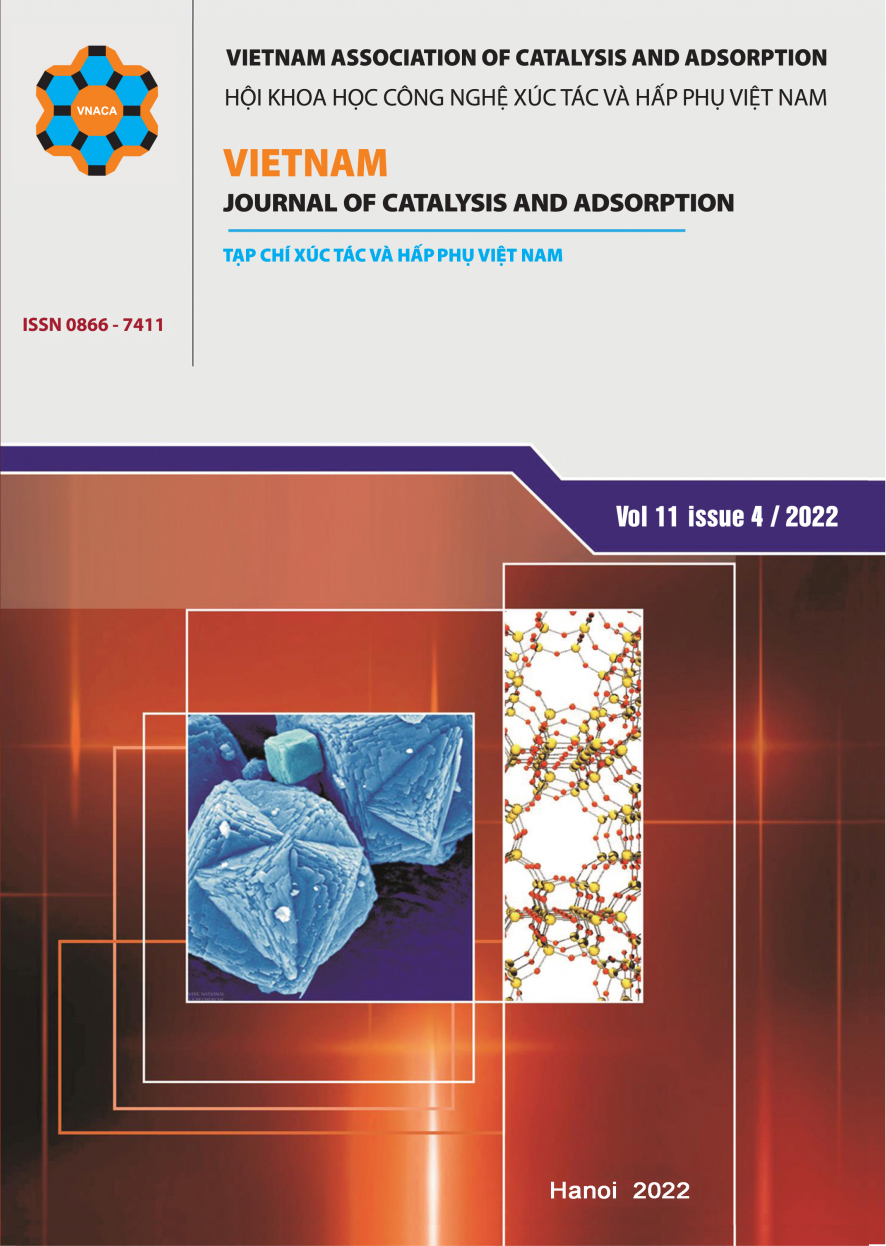Green synthesis of iron nanoparticles using Cleistocalyx operculatus leaves extract and application iron nanoparticles to treat oganic dye Methylene Blue
DOI:
https://doi.org/10.51316/jca.2022.071Keywords:
Green synthesis, Iron nanoparticles, Cleistocalyx operculatus leaves, Methylene BlueAbstract
Green synthesis is a potential method and increasingly popular for synthesizing nanoparticles. In this study, iron nanomaterial was green sythesized using Cleistocalyx operculatus leaves extract as reducing agent. Morphology and structure of the as-prepared nanomaterial was characterized by scanning microscope, X-ray diffraction analysis methods. The collected product is iron nano material with the morphology is paticles with the diameter is approximatly 100 nm. The iron nanomaterial revealed the high degradation performance toward Methylene Blue (MB) solution. The removal color of MB is determined and confirmed by the visible ultraviolet (UV-Vis) absorption spectroscopy which is proportional to the amount of nanomaterial used and is influenced by pH conditions.
Downloads
References
M. Nasrollahzadeh, S. M. Sajadi, M. Sajjadi, and Z. Issaabadi, Interface Science and Technology 28 (2019) 1-27. https://doi.org/10.1016/B978-0-12-813586-0.00001-8
J. Kwon et al., Advanced Materials Technologies 2 (2017) 1600222. https://doi.org/10.1002/admt.201600222
D. Sasidharan, T. R. Namitha, S. P. Johnson, V. Jose, and P. Mathew, Sustainable Chemistry and Pharmacy 16 (2020) 100255. https://doi.org/10.1016/j.scp.2020.100255
S. Jadoun, A. Verma, and R. Arif, Frontiers of Textile Materials (2020) 135-152. https://doi.org/10.1002/9781119620396.ch6
T. A. Saleh, Environmental Technology & Innovation 20 (2020) 101067. https://doi.org/10.1016/j.eti.2020.101067
S. S. Salem and A. Fouda, Biological Trace Element Research 199 (2021) 344-370. https://doi.org/10.1007/s12011-020-02138-3
A. Gour and N. K. Jain, Artificial Cells, Nanomedicine, and Biotechnology 47 (2019) 844-851. https://doi.org/10.1080/21691401.2019.1577878
J. Singh, T. Dutta, K.-H. Kim, M. Rawat, P. Samddar, and P. Kumar, Journal of Nanobiotechnology 16 (2018) 84. https://doi.org/10.1186/s12951-018-0408-4
M. Veiga, E. M. Costa, S. Silva, and M. Pintado, Critical Reviews in Food Science and Nutrition 60 (2020) 873-886. https://doi.org/10.1080/10408398.2018.1540969
P. Mondal, A. Anweshan, and M. K. Purkait, Chemosphere 259 (2020) 127509. https://doi.org/10.1016/j.chemosphere.2020.127509
S. Mortazavi-Derazkola et al., Journal of Alloys and Compounds 820 (2020) 153186. https://doi.org/10.1016/j.jallcom.2019.153186
O. S. ElMitwalli, O. A. Barakat, R. M. Daoud, S. Akhtar, and F. Z. Henari, Journal of Nanoparticle Research 22 (2020) 309. https://doi.org/10.1007/s11051-020-04983-8
N. Jayarambabu, A. Akshaykranth, T. Venkatappa Rao, K. Venkateswara Rao, and R. Rakesh Kumar, Materials Letters 259 (2020) 126813. https://doi.org/10.1016/j.matlet.2019.126813
P. Xu et al., Science of The Total Environment 424 (2012) 1-10. https://doi.org/10.1016/j.scitotenv.2012.02.023
C. D. Raman and S. Kanmani, Journal of Environmental Management 177 (2016) 341-355. https://doi.org/10.1016/j.jenvman.2016.04.034
M. Stefaniuk, P. Oleszczuk, and Y. S. Ok, Chemical Engineering Journal 287 (2016) 618-632. https://doi.org/10.1016/j.cej.2015.11.046
S. Eslami, M. A. Ebrahimzadeh, and P. Biparva, RSC Advances 8 (2018) 26144-26155.
http://doi.org/ 10.1039/C8RA04451A
Y. Liu, X. Jin, and Z. Chen, Science of The Total Environment 627 (2018) 470-479. https://doi.org/10.1016/j.scitotenv.2018.01.241
A. Hamdy, M. K. Mostafa, and M. Nasr, Water Science and Technology 78 (2018) 367-378. https://doi.org/10.2166/wst.2018.306
P. Zhang et al., Journal of Hazardous Materials 384 (2020) 121286. https://doi.org/10.1016/j.jhazmat.2019.121286










